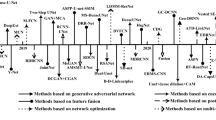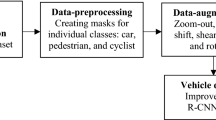Abstract
Road detection is defined as one of the core technology of Advanced Driving Assistance System (ADAS), and this problem is important for improving the recognition accuracy and speed. Though much work has been done concerning road detection, the related questions about non-road areas are not thoroughly considered. Understanding the question is of primary importance in ADAS, we proposed an improved algorithm based on deep learning network for road image redundancy removal. Compared with the most typical road recognition methods, the experimental results show that the proposed method improves the speed of road recognition greatly, while ensuring the accuracy of road recognition to high level.








Similar content being viewed by others
References
Fan J, Yang Z (2020) Deep residual network based road detection algorithm for remote sensing images. In: 2020 5th International Conference on Mechanical, Control and Computer Engineering (ICMCCE), 2020, pp 1723–1726. https://doi.org/10.1109/ICMCCE51767.2020.00378
Wadhawan A, Kumar P (2021) Sign language recognition systems: a decade systematic literature review. Arch Comput Methods Eng 28:785–813. https://doi.org/10.1007/s11831-019-09384-2
Laddha A, Kocamaz MK, Navarro-Serment LE, Hebert M (2016) Map-supervised road detection. In: 2016 IEEE intelligent vehicles symposium (IV), pp 118–123. https://doi.org/10.1109/IVS.2016.7535374
Wang Q, Fang J, Yuan Y (2015) Adaptive road detection via context-aware label transfer. Neurocomputing 158(22):174–183
Yuan Y, Jiang Z, Wang Q (2015) Video-based road detection via online structural learning. Neurocomputing 168(30):336–347
Yu M, Liu L, Shao L (2016) Structure-preserving binary representations for RGB-D action recognition. IEEE Trans Pattern Anal Mach Intell 38(8):1651–1664. https://doi.org/10.1109/TPAMI.2015.2491925
Su Y, Zhang Y, Lu T, Yang J, Kong H (2018) Vanishing point constrained lane detection with a stereo camera. IEEE Trans Intell Transp Syst 19(8):2739–2744. https://doi.org/10.1109/TITS.2017.2751746
Farabet C, CouprieNajman CL, Laurent Y et al (2013) Learning hierarchical features for scene labeling. IEEE Trans Pattern Anal Mach Intell 35(8):1915–1929
Long J, Shelhamer E, Darrell T (2015) Fully convolutional networks for semantic segmentation. In: 2015 IEEE Conference on Computer Vision and Pattern Recognition (CVPR), pp 3431–3440. https://doi.org/10.1109/CVPR.2015.7298965
Krizhevsky A, Sutskever I, Hinton GE (2012) Imagenet classification withdeep convolutional neural networks. In: Advances in neural information processing systems. Neural information processing systems foundation, Lake Tahoe, pp 1097–1105
Kim J, Lee JK, Lee KM (2016) Accurate image super-resolution using very deep convolutional networks. In: 2016 IEEE Conference on Computer Vision and Pattern Recognition (CVPR), pp 1646–1654. https://doi.org/10.1109/CVPR.2016.182
Szegedy C et al (2015) Going deeper with convolutions. In: 2015 IEEE Conference on Computer Vision and Pattern Recognition (CVPR), pp 1–9. https://doi.org/10.1109/CVPR.2015.7298594
Oliveira GL, Burgard W, Brox T (2016) Efficient deep models for monocular road segmentation. In: 2016 IEEE/RSJ International Conference on Intelligent Robots and Systems (IROS), pp 4885–4891. https://doi.org/10.1109/IROS.2016.7759717
Badrinarayanan V, Kendall A, Cipolla R (2017) SegNet: a deep convolutional encoder–decoder architecture for image segmentation. IEEE Trans Pattern Anal Mach Intell 39(12):2481–2495. https://doi.org/10.1109/TPAMI.2016.2644615
Teichmann M, Weber M, Zöllner M, Cipolla R, Urtasun R (2018) MultiNet: real-time joint semantic reasoning for autonomous driving. In: 2018 IEEE intelligent vehicles symposium (IV), pp 1013–1020. https://doi.org/10.1109/IVS.2018.8500504
Saha S, Wang Z, Sadda S, Kanagasingam Y, Hu Z (2020) Visualizing and understanding inherent features in sd-oct for the progression of age-related macular degeneration using deconvolutional neural networks. Appl AI Lett 1(1):1–11
Cordts M et al (2016) The cityscapes dataset for semantic urban scene understanding In: 2016 IEEE Conference on Computer Vision and Pattern Recognition (CVPR), pp 3213–3223. https://doi.org/10.1109/CVPR.2016.350
Wang W, Wang N, Wu X, You S, Neumann U (2017) Self-paced cross-modality transfer learning for efficient road segmentation. In: 2017 IEEE International Conference on Robotics and Automation (ICRA), pp 1394–1401. https://doi.org/10.1109/ICRA.2017.7989166
Chen L, Papandreou G, Kokkinos I, Murphy K, Yuille AL (2018) DeepLab: semantic image segmentation with deep convolutional nets, atrous convolution, and fully connected CRFs. IEEE Trans Pattern Anal Mach Intell 40(4):834–848. https://doi.org/10.1109/TPAMI.2017.2699184
Badrinarayanan V, Kendall A, Cipolla R (2017) SegNet: a deep convolutional encoder-decoder architecture for image segmentation. IEEE Trans Pattern Anal Mach Intell 39(12):2481–2495. https://doi.org/10.1109/TPAMI.2016.2644615
Cheng G, Wang Y, Xu S, Wang H, Xiang S, Pan C (2017) Automatic road detection and centerline extraction via cascaded end-to-end convolutional neural network. IEEE Trans Geosci Remote Sens 55(6):3322–3337. https://doi.org/10.1109/TGRS.2017.2669341
Lee TS (1996) Image representation using 2D Gabor wavelets. IEEE Trans Pattern Anal Mach Intell 18(10):959–971. https://doi.org/10.1109/34.541406
Dollár P, Zitnick CL (2013) Structured forests for fast edge detection. In: 2013 IEEE International Conference on Computer Vision, pp 1841–1848. https://doi.org/10.1109/ICCV.2013.231
Muñoz-Bulnes J, Fernandez C, Parra I, Fernández-Llorca D, Sotelo MA (2017) Deep fully convolutional networks with random data augmentation for enhanced generalization in road detection. In: 2017 IEEE 20th International Conference on Intelligent Transportation Systems (ITSC), pp 366–371. https://doi.org/10.1109/ITSC.2017.8317901
Han X, Lu J, Zhao C, You S, Li H (2018) Semisupervised and weakly supervised road detection based on generative adversarial networks. IEEE Signal Process Lett 25(4):551–555. https://doi.org/10.1109/LSP.2018.2809685
Geiger A, Lenz P, Urtasun R (2012) Are we ready for autonomous driving? The KITTI vision benchmark suite. In: 2012 IEEE Conference on Computer Vision and Pattern Recognition, pp 3354–3361. https://doi.org/10.1109/CVPR.2012.6248074
Alvarez JM, Gevers T, Lecun Y, et al (2012) Road scene segmentation from a single image. In: European Conference on Computer Vision. Springer, pp 376–389
Shelhamer E, Long J, Darrell T (2017) Fully convolutional networks for semantic segmentation. IEEE Trans Pattern Anal Mach Intell 39(4):640–651. https://doi.org/10.1109/TPAMI.2016.2572683
Gao J, Wang Q, Yuan Y (2017) Embedding structured contour and location prior in siamesed fully convolutional networks for road detection. In: 2017 IEEE International Conference on Robotics and Automation (ICRA), pp 219–224. https://doi.org/10.1109/ICRA.2017.7989027
Mohan R (2014) Deep deconvolutional networks for scene parsing. Comput Sci 76(5):1411–1418
Garnett N et al (2017) Real-time category-based and general obstacle detection for autonomous driving. In: 2017 IEEE International Conference on Computer Vision Workshops (ICCVW), pp 198–205. https://doi.org/10.1109/ICCVW.2017.32
Caltagirone L, Scheidegger S, Svensson L et al (2017) Fast LIDAR-based road detection using fully convolutional neural networks. In: 2017 IEEE intelligent vehicles symposium (IV), Los Angeles. IEEE, pp 1019–1024
Mendes CCT, Frémont V, Wolf DF (2016) Exploiting fully convolutional neural networks for fast road detection. In: 2016 IEEE International Conference on Robotics and Automation (ICRA), pp 3174–3179. https://doi.org/10.1109/ICRA.2016.7487486
Funding
Funding was provided by GDAS’ Project of Building a World-class Research Institution in China (2020GDASYL-20200402007).
Author information
Authors and Affiliations
Corresponding author
Additional information
Publisher's Note
Springer Nature remains neutral with regard to jurisdictional claims in published maps and institutional affiliations.
Rights and permissions
About this article
Cite this article
Yang, S., Wang, H. & Chen, Q. An improved algorithm based on deep learning network for road image redundancy removal. J Supercomput 78, 10385–10404 (2022). https://doi.org/10.1007/s11227-021-04302-5
Accepted:
Published:
Issue Date:
DOI: https://doi.org/10.1007/s11227-021-04302-5




